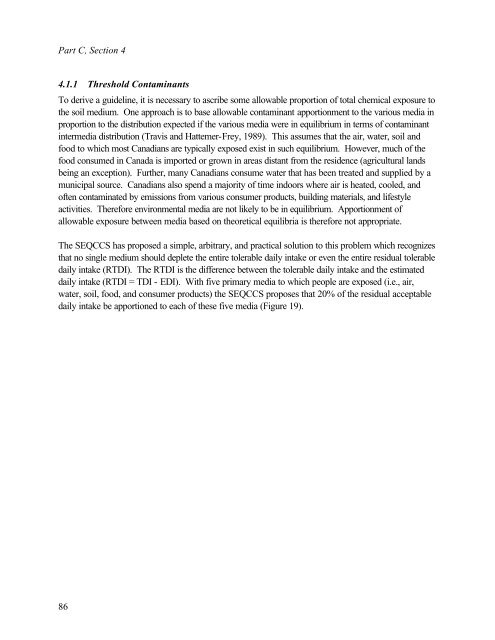Protocol for the Derivation of Environmental and Human ... - CCME
Protocol for the Derivation of Environmental and Human ... - CCME
Protocol for the Derivation of Environmental and Human ... - CCME
You also want an ePaper? Increase the reach of your titles
YUMPU automatically turns print PDFs into web optimized ePapers that Google loves.
Part C, Section 4<br />
4.1.1 Threshold Contaminants<br />
To derive a guideline, it is necessary to ascribe some allowable proportion <strong>of</strong> total chemical exposure to<br />
<strong>the</strong> soil medium. One approach is to base allowable contaminant apportionment to <strong>the</strong> various media in<br />
proportion to <strong>the</strong> distribution expected if <strong>the</strong> various media were in equilibrium in terms <strong>of</strong> contaminant<br />
intermedia distribution (Travis <strong>and</strong> Hattemer-Frey, 1989). This assumes that <strong>the</strong> air, water, soil <strong>and</strong><br />
food to which most Canadians are typically exposed exist in such equilibrium. However, much <strong>of</strong> <strong>the</strong><br />
food consumed in Canada is imported or grown in areas distant from <strong>the</strong> residence (agricultural l<strong>and</strong>s<br />
being an exception). Fur<strong>the</strong>r, many Canadians consume water that has been treated <strong>and</strong> supplied by a<br />
municipal source. Canadians also spend a majority <strong>of</strong> time indoors where air is heated, cooled, <strong>and</strong><br />
<strong>of</strong>ten contaminated by emissions from various consumer products, building materials, <strong>and</strong> lifestyle<br />
activities. There<strong>for</strong>e environmental media are not likely to be in equilibrium. Apportionment <strong>of</strong><br />
allowable exposure between media based on <strong>the</strong>oretical equilibria is <strong>the</strong>re<strong>for</strong>e not appropriate.<br />
The SEQCCS has proposed a simple, arbitrary, <strong>and</strong> practical solution to this problem which recognizes<br />
that no single medium should deplete <strong>the</strong> entire tolerable daily intake or even <strong>the</strong> entire residual tolerable<br />
daily intake (RTDI). The RTDI is <strong>the</strong> difference between <strong>the</strong> tolerable daily intake <strong>and</strong> <strong>the</strong> estimated<br />
daily intake (RTDI = TDI - EDI). With five primary media to which people are exposed (i.e., air,<br />
water, soil, food, <strong>and</strong> consumer products) <strong>the</strong> SEQCCS proposes that 20% <strong>of</strong> <strong>the</strong> residual acceptable<br />
daily intake be apportioned to each <strong>of</strong> <strong>the</strong>se five media (Figure 19).<br />
86
















